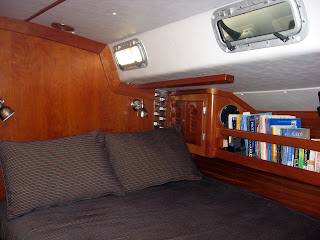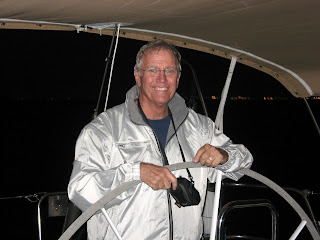We experiencd an easy, relaxed passage to Cabo San Lucas, not because The Captain suddenly and unbelievably lost his drive, but because there were no winds. Just temperate, pleasant, peaceful days. The First Mate could cruise like this forever!
January 14th – The sun shines down from a gorgeous blue sky. There is no wind ruffling anything out there. With two nights’ travel ahead of us and no wind calling us out the harbor at Marina Coral, E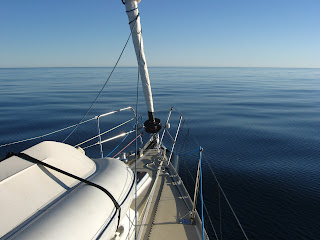 nsenada, The Captain allows The First Mate to prepare a good breakfast before we depart. Eggs Benedict are served. At 11:00, we motor out on a still, glassy sea. In the early afternoon, the wind freshens a bit. The Captain declares that it is time to raise the spinnaker and finally put the crew thru that drill. “Maybe the wind will drop”, hopes The First Mate, but no such luck. The Captain is determined to raise the brand new asymmetrical spinnaker we designed last winter, and the rest of the darn crew is just as enthusiastic. At the helm, The First Mate watches with growing apprehension as all the spinnaker paraphernalia appear o
nsenada, The Captain allows The First Mate to prepare a good breakfast before we depart. Eggs Benedict are served. At 11:00, we motor out on a still, glassy sea. In the early afternoon, the wind freshens a bit. The Captain declares that it is time to raise the spinnaker and finally put the crew thru that drill. “Maybe the wind will drop”, hopes The First Mate, but no such luck. The Captain is determined to raise the brand new asymmetrical spinnaker we designed last winter, and the rest of the darn crew is just as enthusiastic. At the helm, The First Mate watches with growing apprehension as all the spinnaker paraphernalia appear o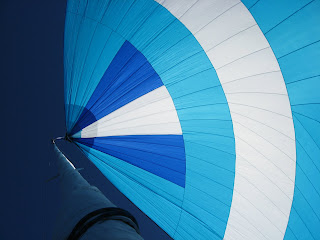 n deck. Sheets (lines) are threaded everywhere. The Spinnaker is attached and run up the halyard. The sheath covering is pulled up and out the spinnaker blossoms. It miraculously flies without one hitch. It’s beautiful. Even The First Mate is impressed. We ghost along in the light wind with The Captain happily tweaking this and that.
n deck. Sheets (lines) are threaded everywhere. The Spinnaker is attached and run up the halyard. The sheath covering is pulled up and out the spinnaker blossoms. It miraculously flies without one hitch. It’s beautiful. Even The First Mate is impressed. We ghost along in the light wind with The Captain happily tweaking this and that.

January 15th - David, to The First Mate’s joy, is a fisherperson. A belated Christmas gift to his mother, “The Cruiser’s Handbook of Fishing”, is a veritable bible of everything one ever needs to know about this endeavor and maybe more. He has the fishing pole out and in the water as soon as possible. On the way into Isla San Martin for a breakfast stop, he lands his first fish. Wow, this is the way to go!
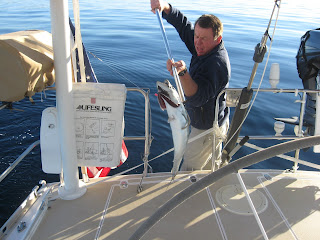 The Captain gaffs it right thru the middle. Not a pretty placement, but the fish is securely ours. Out comes the s
The Captain gaffs it right thru the middle. Not a pretty placement, but the fish is securely ours. Out comes the s pray bottle filled with rotgut vodka. Sprayed in the gills, this is supposed to subdue any and all fish. It takes more than a few sprays. So many in fact that The First Mate goes below to retrieve the trusty mallet, but The Captain is determined. Eventually the fish lies in a drunken stupor, not exactly dead, but not flipping around either.
pray bottle filled with rotgut vodka. Sprayed in the gills, this is supposed to subdue any and all fish. It takes more than a few sprays. So many in fact that The First Mate goes below to retrieve the trusty mallet, but The Captain is determined. Eventually the fish lies in a drunken stupor, not exactly dead, but not flipping around either.
The question now arises as to what kind of fish we have lying here. Though “The Cruiser’s Handbook of Fishing” is complete with detailed drawings of everything down to the complete disassembling and, hopefully, reassembling of the spinning reel, something The First Mate knows she’ll never do, its descriptions and drawings of edible fish is sparse. It does spend a lengthy chapter on the sobering details of toxic and (worse) poisonous sea creatures, a topic one should be cognizant of, but not one The First Mate wanted to think about just then. What kind of fish do we have? Obviously, another book is needed in our floating library. One with full color pictures of all fish - good, bad and indifferent. Our fish is of the indifferent category. It certainly is not of the yummy variety like a tuna. David, deeply disappointed, declares it a game fish, something like a mackerel. Edible, but not great. Never the less, duly dispatched, the fillets are put on ice for dinner that evening.
In the morning, we anchor in a small bay below a tiny fishing village for a brief breakfast stop. There are several pangas or small boats out on the bay. Using air compressors, the men are diving for lobsters. The First Mate’s brain goes into full tilt. According to the guidebooks, these local fishermen are often eager to trade their catch for items such as cans of soda, T-shirts or children’s school supplies. She mentions this and is given a highly skeptical look from The Captain. Stymied, she goes about putting out a breakfast of lox and bagels. David is out on deck when one of those pangas approaches. He is asked whether he’d be interested in 10 (ten!) lobsters. Overhearing, I yell up that 10 is too many. How am I ever going to cook and store 10 lobsters? Try 5. “How much?” David asks. 6 (six!) cans of soda, Coke preferred. We make the trade, as The First Mate scornfully eyes The Captain. We now have 5 Spiney Lobsters cavorting in our orange crab bucket. They are huge. The First Mate is relieved she only asked for 5, but later that afternoon when bodies have been separated from the edible tails, she realizes that the cookable part is really quite small. Ten lobsters would have been very manageable, and just think of all the delectable dishes she could have made with that bounty! Next time.
The First Mate is relieved she only asked for 5, but later that afternoon when bodies have been separated from the edible tails, she realizes that the cookable part is really quite small. Ten lobsters would have been very manageable, and just think of all the delectable dishes she could have made with that bounty! Next time.
After breakfast, we head back out. The wind has freshened a bit, and we are able to raise that spinnaker. After yesterday’s successful and uneventful raising and lowering of the thing, The First Mate is not concerned. Up it goes. Even in the light wind, it billows out and fills with a resounding, satisfying pop. Averaging around 8 knots of wind, we enjoy a peaceful, easy afternoon sail south.
For lunch, a few fish fillets are sautéed and served on salad. As expected, they are marginal and a bit tough, but on salad, they work fine. Besides, we are all looking forward to a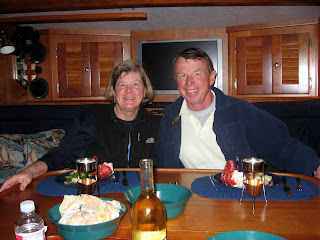 lobster dinner. Not much can beat that. The wind dies a half hour before sunset and the engine is started again. By dinnertime, it is so calm that The Captain powered down, put on autopilot and we are all able to eat below savoring our steamed lobster tails with melted butter. As Al keeps saying, “Life just doesn’t get any better!”
lobster dinner. Not much can beat that. The wind dies a half hour before sunset and the engine is started again. By dinnertime, it is so calm that The Captain powered down, put on autopilot and we are all able to eat below savoring our steamed lobster tails with melted butter. As Al keeps saying, “Life just doesn’t get any better!”
We spend that night chasing the wind, alternating between sailing and motor sailing. January 16th - Mostly under motor, we approach Isla Cedros, our next stop. Motoring is really the pits when one is on a sailboat, and we are all a bit down heartened by the lack of wind. We pull into a bay on the northeastern end of the island with the nickname of “The Yacht Club”. That name came about because this is a very common anchorage for cruisers waiting for good weather to either head north or south. We are alone and definitely not concerned about waiting for good weather. The shores are home to a large colony of seals. We see our first elephant seal. It must be siesta time when we arrive, for the shores are covered with the ungainly bodies of seals all in various states of lethargy. I chuckle to myself remembering the cacophony these animals produced in harbors we overnighted in on our way south along the California coast last fall. We are in for it tonight, I think, but the beasts remain strangely quiet all night long. Maybe it’s the nearness to civilization that makes them such noisy, noxious creatures in harbors.
When had been making water for a good party of the day topping off the tanks so we could all take showers this evening. After those much-anticipated showers, dinner and, being mindful of a 4:00 am departure planned in order for us to arrive at Turtle Bay in daylight the next day, we head to bed at 8:30. There was a time when The First Mate would have squawked in protest at this uncivilized and unnatural wake-up call, but she has learned that such unnaturalness is all part of what it takes to get from A to B out here on the water. There’s a lot she’s learned in the last 2 1/2 years of sailing with The Captain. Even standing watches (some watches) is becoming manageable for her. Brainstorming with The Captain, a unique and very workable schedule was devised for this trip. From noon to midnight, we are on 2-hour watches with The First Mate always taking the 2:00 – 4:00 afternoon watch and the 8:00 – 10:00 evening watch. From midnight to noon, we are on 3-hour watches, though The First Mate does not stand a watch during this 12-hour stretch. With a schedule like this, only two men stand deep night watches, giving one man almost a full night off since all he stands is the 10:00 – midnight shift. His next shift starts at 6:00 am which is pretty much on the way to daylight and daytime. With the 2-hour daytime schedule and with The First Mate taking two of those watches, everyone has an easy day with plenty of time to relax or take a nap, if needed. With her two watches and the details of putting out 3 meals plus either afternoon tea or a modified cocktail hour, The First Mate is busy during the day and ready for sleep at 10:00 each evening after her last watch. The schedule is working easily and well. Everyone is happy and able to get enough rest when needed.
January 17th – Reveille occurs at 3:30 am. We head off into the dark. A big difference for The Captain and The First Mate is that we are not donned in full storm regalia, and the deck is not cold and wet. We are definitely in another climate zone. We even slept with a port window opened last night. Shortly after sunrise, we are able to raise sail. David drops the lure. Within minutes, there’s that heart stopping zing of the line. The drill is on. David grabs the line and starts cranking. With the main out, Bill turns us closer to the wind to slow the boat down and then grabs the gaff hook while Sue takes over the helm. Al gets the bottle of vodka, the knife and cutting board. This fish is a fighter. It veers off sharply when it sees the boat. Finally, David has it near enough to the boat for Bill to gaff. It’s a Yellowtail! Now, this is good eating! David is elated with this specimen of fishdom. Bill is delighted to have someone else aboard who wants to carve up this specimen. Sue is planning dinner, and Al’s mouth is already watering! Go, team! David unhooks the lure and casts it out to sea again. He is still carving when --- zing, there goes the line again. This time Bill springs to the line. A second fish is landed. Another Yellowtail! The two are shortly dispatched. The deck is swabbed. The fillets are on ice, and the galley is cleaned when --- zing, there goes the line again. This time it’s a fish like the very first game fish. With the unaccustomed luxury of bei ng able to be picky, this fish is unhooked and set free. Bill resets the line and before it is even fully out there, a fourth fish takes the lure. Another Yellowtail hits the deck, and it’s bigger than the first two. Three Yellowtail, and it’s not yet 11:00 in the morning. We are definitely “in” fish and decide to call a moratorium. The remaining fishdom is spared the onslaughts of the Great Fish Hunters! The First Mate promises sautéed fish fillets for lunch provided no one minds having the same for dinner tonight. There are no protests.
ng able to be picky, this fish is unhooked and set free. Bill resets the line and before it is even fully out there, a fourth fish takes the lure. Another Yellowtail hits the deck, and it’s bigger than the first two. Three Yellowtail, and it’s not yet 11:00 in the morning. We are definitely “in” fish and decide to call a moratorium. The remaining fishdom is spared the onslaughts of the Great Fish Hunters! The First Mate promises sautéed fish fillets for lunch provided no one minds having the same for dinner tonight. There are no protests.

Lunch: Panko Crusted Yellowtail with Ensalada Caprese.
Note: Plastic Plates –this is still a passage!
The Captain claims that the reason w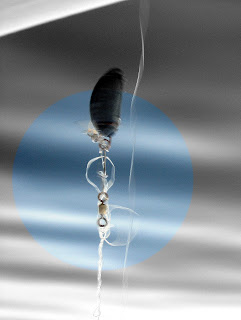 e caught 3 Yellowtail is that David finally relented and used the very non-conventional devise he invented for deep-sea trolling off fast moving sailboats. The problem we had in British Columbia was getting the lure deep enough with a weight that would not tangle and spin the line into a strangle hold of knots, as shown in this picture. David was at first resistant to using this unprofessional looking device. A cross between a bent wire coat hanger and half a baby’s crib mobile with a round shot-put
e caught 3 Yellowtail is that David finally relented and used the very non-conventional devise he invented for deep-sea trolling off fast moving sailboats. The problem we had in British Columbia was getting the lure deep enough with a weight that would not tangle and spin the line into a strangle hold of knots, as shown in this picture. David was at first resistant to using this unprofessional looking device. A cross between a bent wire coat hanger and half a baby’s crib mobile with a round shot-put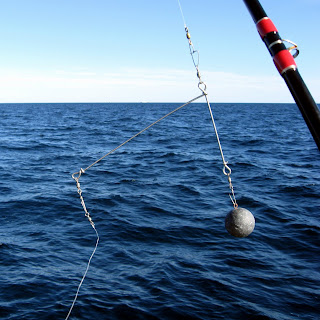 weight at one end and the leader at the other, it certainly doesn’t look like something any respectable deep sea fisherman would use, but after David’s carefully weighted line came up in one of those tangles with which we were quite familiar, he decided to give the monstrosity a try. It did catch salmon for us up north. It did catch the three Yellowtail. Maybe The Captain ought to patent this thing!
weight at one end and the leader at the other, it certainly doesn’t look like something any respectable deep sea fisherman would use, but after David’s carefully weighted line came up in one of those tangles with which we were quite familiar, he decided to give the monstrosity a try. It did catch salmon for us up north. It did catch the three Yellowtail. Maybe The Captain ought to patent this thing!
Later that afternoon, we motor into Turtle Bay. Such a pretty name – such a dismal place with its barren, dry, unremarkable landscape.
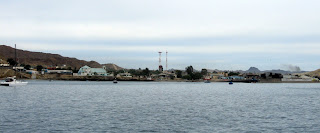
The guidebook refers to poor Turtle B ay as “Coyote Ugly” which, though harsh, proves not to be far off the mark. However, it is one of the few somewhat sheltered anchorages on this coast where cruisers can obtain both a respite and fuel if needed. We do not need fuel having filled our extra plastic containers in San Diego. Al and Sue dingy ashore to purchase eggs, milk and limones while Bill and David transfer fuel from those spare containers to the main tanks.
ay as “Coyote Ugly” which, though harsh, proves not to be far off the mark. However, it is one of the few somewhat sheltered anchorages on this coast where cruisers can obtain both a respite and fuel if needed. We do not need fuel having filled our extra plastic containers in San Diego. Al and Sue dingy ashore to purchase eggs, milk and limones while Bill and David transfer fuel from those spare containers to the main tanks.
January 18th - We wake up to overcast skies, the first we have seen since arriving in San Diego 2 weeks ago, so we cannot complain. Lack of wind, however, is a cause for complaint as we motor out to begin the 240 nm stretch to Magdalena Bay, our next anchorage. Anticipating 2 nights at sea, we resume our watch schedule as we head out of harbor. Not much can be said about this day or the night either. No winds and no fish. Winds did turn around to the east-northeast which, when we did sail, had us heading out to sea. We kept hoping to find better winds the further out we went, but no such luck. We ghosted along in 5 knot winds. A pretty old schooner that had been anchored in Turtle Bay saw our sails and hailed us to find out if winds were better further offshore where we were. In conversation, we discover that he is sailing in tandem with his son who is on a catamaran. They are heading to Cabo, then down the Mexican coast and from there to the Marquesas. The First Mate is intrigued. She would love to talk to them. The Marguesas – one of the longest passages – a good 3-weeks even on Avante. Would we ever make that crossing and then head on to the Pacific Islands? I hope so.

One benefit of the day’s cloud layer is a spectacular sunset that evening.
There is one very bright star or planet that shows itself first right after sunset. None of us know what the name of this celestial body is, but we are fascinated watching its appearance higher above the horizon each night. The First Mate thinks another book to add to our floating library is one on celestial identification, hopefully for both Northern and Southern Hemispheres! She has found that one of the side benefits of her nightly 8:00 to 10:00 evening watch is that she gets to see and monitor the same sky changing each night. Not being versed in the names and identification of all those bright bodies circling above her, she has found some prominent on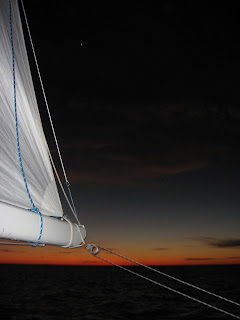 es that she looks for each night to see where they are. Some she actually misses as nightly companions when they slowly slide below the horizon. Astronomy has never particularly caught her imagination, but now she fully understands how shepherds in their fields at night studied and named these bodies. Who is a budding astronomer out there? Can any of you reading this tell me the name of the bright, bold body we see first thing in the evening?
es that she looks for each night to see where they are. Some she actually misses as nightly companions when they slowly slide below the horizon. Astronomy has never particularly caught her imagination, but now she fully understands how shepherds in their fields at night studied and named these bodies. Who is a budding astronomer out there? Can any of you reading this tell me the name of the bright, bold body we see first thing in the evening?
The temperatures at night have become quite pleasant. All of us have shed the heavier storm gear. The First Mate is down to one layer of fleece for her evening watch, and she considers this shedding of clothing quite an improvement.
January 19th – Overcast and still at sunrise, but by 7:30, we are finally able to raise sail in a soft 6 - 7 knot breeze. Because it is blowing from the rear, we barely make 3 knots of speed over ground, but as we are all tired of engine noise and vibration, this is most acceptable. In addition, there is the not-so-little consideration of needing to conserve fuel unless we want to rely on the sail to get us into a slip in the marina in Cabo San Lucas – not an easy task for a boat this size.
We slowly sail over Uncle Sam Bank, known for its abundance of fish. David has been waiting for this. He’s ready. Gear is out. We’re all waiting for that resounding zing. Finally – zing! We spring to action. David has visions of Yellowtail and more dancing in his head. It’s silvery looking, maybe blue. “Oh, no, it’s a Jack,” says David. “Maybe not,” says Bill with gaff at the ready. “No, it’s a nasty old Green Jack. Don’t ga…” starts David, but The Captain is too primed not to gaff and in goes the spike with a lethal strike right thru the heart. The fish hadn’t a chance. David unhappily studies the fish and declares that it is indeed a “Nasty Green Jack” whose meat is barely edible as far as he’s concerned. Resigned to the task of cutting up a fish he doesn’t want, David decides to try a new technique he just read about in our book where one bleeds a larger fish before cutting it up. As David holds the fish outboard letting all this bright red blood drain, I’m wondering how many sharks for miles around have their noses twitching and are heading our way or even right now are swimming under our boat ready to go into one of those shark feeding frenzies. The “nasty” fillets are on ice with David still bemoaning the poor fish. I tell him it will taste just fine baked with tomatoes, onions, peppers, garlic and wine.
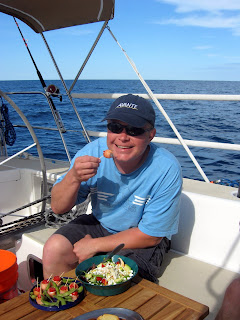
We spend the day slowly sailing and slowly fishing. For lunch, I use the last of the mackerel fish to make a kind of tuna salad. It definitely is good this way mixed with some mayonnaise and spices to season it. Two more fish are caught but they are exactly like the “Nasty Green Jack” we caught earlier and are released as non-acceptable. Another one bites thru the line, and the poor thing escapes with a lure attached.
At 3:00, The Captain informs everyone that the ocean is warm enough (70 degrees) for a swim and a shower on deck. The First Mate demurs. There is no way that water is 70 degrees to her way of thinking. If so, it would have to be 100 degrees outside for her to get in that water. Besides, we are totally out in the ocean. There is no sight of land, and there’s no reading on the depth gauge which means we are real deep, unfathomably deep. It’s just a little too wild for her. As The Captain prepares to heave-to so we can stop sailing and remain stationary (if such a thing is possible on an ocean), the line sets off with a resounding zing. All spring to action. There is great relief that it is not another “Nasty Green Jack” but we don’t know what we have caught. What photos we have in our books are analyzed. It is decided we have some kind of tuna. The First Mate notes that it is somewhat similar to the fish we caught and processed earlier and postulates that maybe the other one was also of the tuna variety.
Swimming and showers are delayed while the fish is cleaned. David bleeds the thing, and all the blood goes overboard. Analyzing this occurance, The Captain decides to motor up and get well clear of the area before he resumes his idea of a swim and shower. To The First Mate’s way of thinking, we’d have to sail to a different ocean before she’d get in that water now. If those guys want to be shark bait, that’s their problem. She goes below to read while the men carouse above, yelling down about how refreshing this all is and what a great time I am missing. I don’t think so. Waiting for the commotion to subside, I mentally hold my breath until three intact bodies are back on the boat.
We are still not sure whether the last fish we caught was tuna or not, though the flesh certainly looks like Ahi tuna. The First Mate cuts off a thick slice, coats it with panko and sears it as one would an ahi tuna. She mixes up soy sauce and wasabi and serves the crew a tasting sample. The smile from David is the kind that “warms a mother’s heart”. Just for fun, she gives the same treatment to a piece of the “Nasty Green Jack” we caught earlier in the day. The verdict is “also a tuna.” The fishermen lament the two that were caught and released, and the First Mate returns to the galley to bread more slices of our Ahi Tuna in preparation for dinner. With light winds at dinnertime, we are all able to eat below and enjoy our feast.
We slowly sail all night. In the late morning, we approach Bahia Santa Maria just north of Bahia Magdalena. It is supposed to be a pretty, quiet bay often by-passed by cruisers eager to get to Magdalean Bay or Mag Bay, as it’s commonly called by cruisers. We plan to anchor in Bahia Santa Maria for lunch before proceeding on to Mag Bay for the night.
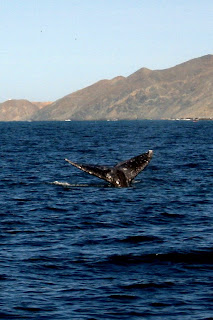
Just outside the entrance, a humpback whale surfaces not too far from the boat. The First Mate is finally able to get some good pictures of a whale, something she had never had the opportunity to do all the time we were in the Pacific Northwest. What a thrill!
We anchor, and here in this quiet bay, in about 25’ of water, The First Mate dons her swimsuit  and takes a swim off the transom of Avante. It is the first time we have been in waters warm enough for her to do this, and it is totally delightful. Al joins her and later both enjoy soaking up the sun as they dry off in the warm air. The First Mate thinks this warm weather sailing is going to do mind and body good!
and takes a swim off the transom of Avante. It is the first time we have been in waters warm enough for her to do this, and it is totally delightful. Al joins her and later both enjoy soaking up the sun as they dry off in the warm air. The First Mate thinks this warm weather sailing is going to do mind and body good!
Al, who had decided to use The First M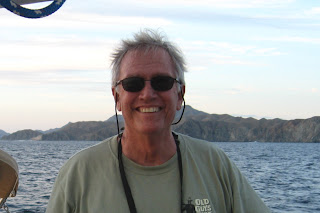 ate’s shampoo instead of going below to get his own, discovers what a “bad hair” day is. He gives us all belly laughs as we rib him with such names as “Tweety Bird” and “Fluffy”. He definitely will not do that again! The next morning he emerges from the head with his head plastered with water. The fluff will not abate!
ate’s shampoo instead of going below to get his own, discovers what a “bad hair” day is. He gives us all belly laughs as we rib him with such names as “Tweety Bird” and “Fluffy”. He definitely will not do that again! The next morning he emerges from the head with his head plastered with water. The fluff will not abate!

After lunch we set sail for Mag Bay arriving just at sunset, and again we enjoy a terrific, fiery show. Between watching all the whales feeding along the shore and watching this sunset, it is a good thing the bay is so huge and deep and that the intended anchorage is straightforward and easy. We do have to be watchful as we motor in, though not for rocks and shallows as we did up north, but for an armada of pangas each with a single light at the end of a 5’ pole raised like a mast in the middle of the boat. Each panga appears to hold one solitary man. We cannot figure out what these boats are doing though we surm ise that it must be some kind of fishing. The pangas are just sitting out there on the water, in the growing dark, not appearing to be doing anything or going anywhere. Really strange. The First Mate decides she will try to find out as soon as she has a chance just what this fleet of panga fishermen was up to.
ise that it must be some kind of fishing. The pangas are just sitting out there on the water, in the growing dark, not appearing to be doing anything or going anywhere. Really strange. The First Mate decides she will try to find out as soon as she has a chance just what this fleet of panga fishermen was up to.
We enjoy another dinner of Ahi Tuna, and we each have a quiet, full night of sleep until a 5:00 wake-up call. We have 150 more miles to go to finally arrive in Cabo San Lucas. With the marginal winds we have had, we expect that to be another 30 hours. Thus, the dawn departure again, so that we can arrive in the harbor in daylight.
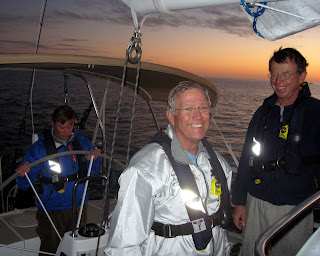
Crew looks way too happy and alert for such an early hour.
To be noted: There are no sanctioned photos of The First Mate at this hour before sunrise.
January 21st – The Captain’s weather info has forecast light rain by the time we are to arrive in Cabo. The increasing build-up of grey clouds seems to point in that direction. Clouds or no clouds, we are comfortable and happy in the warming temperatures. We motor or slowly sail all day with nothing to break the churning away of the miles except a zing now and then on the lin e. Two bites get away or maybe they are seaweed. The one fish David does haul into the boat is a super keeper – a beautiful, big Yellowtail Tuna. David, in typical fisherman fashion, proclaims it to be at least 30 pounds. He should know. He hauled it in. The First Mate brings out the scale. The Captain tries to balance himself and the fish on the scale and announces that the fish is between 18 and 25 pounds. Whatever the weight, The First Mate knows there is enough fish there for several meals. The trick for her now is to come up with some tuna recipes other than a panko or sesame seed crusted sautéed presentation. What do you do with tuna? Any ideas out there? She tries a recipe that’s akin to tomato sauce with tuna chunks on linguini. Definitely a no go. Too much seasoning or too much tuna. She has decided that tuna may not lend itself to a wide ranch of dishes like salmon or fillet of sole does. Maybe it’s just panko crusted tuna sautéed or grilled and then served with a variety of sauces. Sauces are good. Maybe she’ll just concentrate on sauces.
e. Two bites get away or maybe they are seaweed. The one fish David does haul into the boat is a super keeper – a beautiful, big Yellowtail Tuna. David, in typical fisherman fashion, proclaims it to be at least 30 pounds. He should know. He hauled it in. The First Mate brings out the scale. The Captain tries to balance himself and the fish on the scale and announces that the fish is between 18 and 25 pounds. Whatever the weight, The First Mate knows there is enough fish there for several meals. The trick for her now is to come up with some tuna recipes other than a panko or sesame seed crusted sautéed presentation. What do you do with tuna? Any ideas out there? She tries a recipe that’s akin to tomato sauce with tuna chunks on linguini. Definitely a no go. Too much seasoning or too much tuna. She has decided that tuna may not lend itself to a wide ranch of dishes like salmon or fillet of sole does. Maybe it’s just panko crusted tuna sautéed or grilled and then served with a variety of sauces. Sauces are good. Maybe she’ll just concentrate on sauces.
No wind that night. We chug our way toward Cabo, all of us eager for the miles to fall away under our keel. By 6:00 in the morning we can see the coastline down toward Cabo. By 9:30, we are approaching the harbor entrance. The sky is overcast but showing signs of clearing.

A tourist “pirate ship” comes out of the harbor and motors west up the coast. It offers an interesting play of images.

We are under blue skies and sun as we enter the harbor. Lands End and the famous arch are impressive – even if the arch has had to be cemented to keep it in one piece.
The harbor is a freeway of all kinds of boating activity. Sailboats, cruisers, paragliders, skidoes, pangas, you name it; it’s out there. It’s a free-for-all of water activity with no such thing as a “no wake” zone. Shortly after passing the markers into the harbor, we have to make a left turn down a fairway to get to the fuel dock, which according to the guidebook, may or may not be open. The First Mate at the helm is aghast at the activity. She wishes desperately for a left turn signal and that if she had one, it would be attended to! What a mess! Backing Avante down to hold place, she waits for a break in the traffic. Finally there’s enough space to get Avante turned left. Left we go, but the impatient motor boat behind us decides to pass on the left to go straight ahead. Well, there’s nothing to be done. With another boat bearing down on us, we continue forward. The guy behind us makes a huge turn to circle us and then blithely screams ahead rudely cutting off the boat bearing down toward us. It’s a game of chicken out here. It reminds her of driving a car in Naples, Italy when they lived there in the ‘70’s. Before starting one’s car, you made sure your hand signals worked (hand as in your hand and fingers) and you made sure the car horn worked. After that, all it took to drive the streets of Naples was cajones. She drove those streets back then; she can handle this boat traffic out here now.
While fueling, Bill radios and obtains a slip in the Marina Cabo San Lucas. Back into the traffic we go, and we are soon in a very narrow slip with the help of several marina staff who were out there waiting for us. How very nice! The marina is clean, new and well equipped. We get the boat secured. Showers are next on everyone’s list. The Captain heads off to sign in with the marina office and to walk into town to take care of paperwork with Mexican officials. Although it is much simpler than it used to be, we still have to notify officials and get new “despachos” every time there is a change in our crew/guest manifest. Thus Al and David must be signed off Avante. It is a pain for The Captain, but it must be done.

After cocktails on Avante, we head out in search of dinner, ending up at a really good restaurant with the improbable name of “Desperados”. We enjoy the music of an extremely good guitarist playing in classic Spanish style. His finger work on the strings is wonderful. Al goes up to give the man a tip, which turns out to be a surprise for The First Mate. The next s ong we hear is “Happy Birthday” and a wonderful flan is presented. What a special way to celebrate The First Mate’s birthday! We arrive in Cabo San Lucas, a passage of over 800 miles. We are showered, refreshed and enjoying a delicious meal in a great restaurant with absolutely beautiful music. Life is good. No complaints here!
ong we hear is “Happy Birthday” and a wonderful flan is presented. What a special way to celebrate The First Mate’s birthday! We arrive in Cabo San Lucas, a passage of over 800 miles. We are showered, refreshed and enjoying a delicious meal in a great restaurant with absolutely beautiful music. Life is good. No complaints here!
.jpg)
.jpg)
